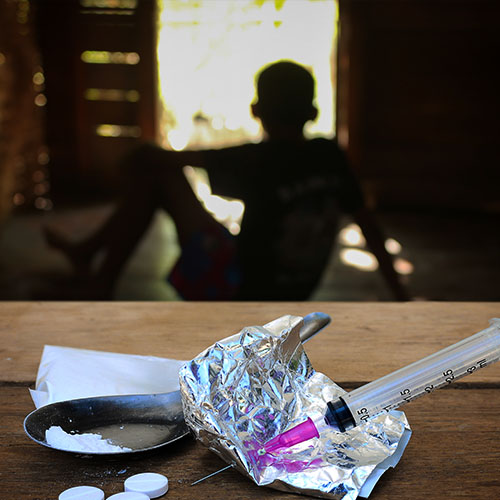For more than a hundred years, two basic assumptions have been put forth by public-health officials. One is that vaccines are safe. The second is that vaccines are effective for the conditions for which they’re prescribed.
Lethal Injections
The public and our legislators have, by and large, accepted these assumptions as true, and as a result it is now compulsory in many states that children have as many as 33 inoculations before entering school. Some of these are given as early as the first few weeks of life.
The problem is that if you dig around in the medical establishment’s own archives, you soon discover that neither of these assumptions — that vaccines are safe, and that they are effective — is necessarily true. In fact, the situation with vaccination is analogous to that of chemotherapy: Both are presented to the public as efficacious and safe, when, in reality, with a few exceptions for each, they are neither. In both cases, then, personal decision-making requires research.
Let’s start with The Journal of Pediatrics, which ran an October 1997 article summarizing reports to the Vaccine Adverse Event Reporting System. Between 1991 and 1994, 38,787 adverse reactions following vaccination were reported to this clearinghouse. Most of these cases occurred within two weeks of vaccination, and they ranged from less than serious reactions to deaths, which were most prevalent among children from one to three months old. Since only about one tenth of vaccine-induced reactions are ever reported, these numbers coming out of VAERS vastly understate the real incidence of vaccine-associated complications. You also have to consider that this reporting system is not dealing with long-term complications. While long-term causality is hard to prove, there are thousands of reports documenting cases of meningitis, asthma, inflammatory bowel disease, diabetes, autism, chronic encephalitis, multiple sclerosis, cancer, and rheumatoid arthritis, among other conditions, that seem to be linked to vaccines.
But the medical establishment does not generally want to acknowledge either the short- or long-term problems that vaccines can cause. This is something that concerns an increasing number of medical consumers, including Alan Phillips, the founding director of Citizens for Healthcare and Freedom, a Durham, North Carolina, group dedicated to raising awareness about vaccine issues and supporting the right to choose. “The fact is,” Phillips says, “that in this country over a hundred deaths are reported each year following vaccination.” Furthermore, “the FDA admits that 90 percent or more of serious vaccine adverse events are not even reported, and independent sources raise that figure to as much as 95 or 97 percent. So,” says Phillips, “any pediatrician or other person who says that this doesn’t happen is uninformed.”
One of the problems that crops up with vaccine after vaccine is that immunization often provides only temporary immunity, whereas getting the disease naturally usually confers permanent immunity. Barbara Loe Fisher, president of the National Vaccine Information Center, of Vienna, Virginia, notes, “That is one of the reasons why they have to keep giving booster doses. With DPT [diphtheria, pertussis (whooping cough), and tetanus] and OPV [oral polio vaccine], you need up to five doses. They told us that with the measles vaccine, one dose was needed for life. Then we started seeing more and more measles in vaccinated children. Now they are asking for a second dose …. Already, measles has mutated into a more serious form of the illness. When babies are no longer protected by their mothers’ antibodies because their mothers have only been vaccinated [and have not actually had measles] … these little babies are going to get a more severe form of measles.”
There is a lot of guesswork behind vaccination practices. This bothers Jamie Murphy, author of What Every Parent Should Know About Childhood Immunization (Earth Healing Products), in which she stresses that vaccines are suspensions of infectious agents used to induce, artificially, immunity against specific diseases. The aim of vaccination is to mimic the process of naturally occurring infection through synthetic means. Theoretically, vaccines produce a mild-to-moderate episode of infection in the body with only temporary and slight side effects. But in reality, they may be causing diseases rather than preventing them. “Vaccines produce disease or infection in an otherwise healthy person,” Murphy says. “And so, in order to allegedly produce something good, one has to do something bad to the human body — that is, induce an infection or a disease in an otherwise healthy person that may or may not have ever happened.”
Thus, she explains, “You have a situation in which everyone is being given a disease with no control over that disease, because once you inject a vaccine into a person’s body, whether it contains bacteria or viruses or split viruses or whatever, you have no control over the outcome. Of course, what they want the vaccination to do is initiate the building up of our immune defenses, just [as] a regular infection would do. The problem is that the medical profession and science do not know, and have never known, what the infecting dose of an infection really is. So, they’re really guessing at the amount of antigen [a substance that stimulates an immune response] and other supplementary chemicals that they put in the vaccine.”
Not only must doctors guess at the optimal amounts of vaccine components to use but the answers they come up with are thereafter the same for everyone. The standardization that characterizes vaccination practice is a problem brought up by Healthcare director Phillips, writing in the October/November 1997 issue of the alternative magazine Nexus. Immunization practice, he points out, assumes that all children, regardless of age and size, are virtually the same. “An eight-pound two-month-old receives the same dosage as a 40-pound five-year-old,” Phillips says. “Infants with immature, undeveloped immune systems may receive five or more times the dosage (relative to body weight) as older children.”
Another problem, vaccine critics point out, is that introducing antigens directly into the bloodstream can prove dangerous. Jamie Murphy elaborates: “When a child gets a naturally occurring infection, like measles, which is not a serious disease, the body reacts to that in a very set way. The germs go in a certain part of the body through the throat and into the different immune organs, and the body combats the disease in its own natural way.
“When you inject a vaccine into the body,” she continues, “you’re actually performing an unnatural act because you are injecting directly into the blood system. That is not the natural port of entry for that virus. In fact, the whole immune system in our body is geared to prevent that from happening. What we’re doing is giving the virus or the bacteria carte blanche entry into our bloodstream, which is the last place you want it to be. This increases the chance for disease, because viral material from the vaccine stays in the cells and is not completely defeated by the body’s own defenses. You overload the body.”
The generally accepted view is that vaccines are the magic bullets responsible for eradicating or drastically curtailing a variety of infectious diseases. But there’s an alternative view — that these diseases were diminishing on their own, without vaccines. Harris Coulter, Ph.D., coauthor of A Shot in the Dark (Avery), tells us, “The incidence of all of these infectious diseases was dropping very rapidly, starting in the 1930s. After World War 11, the incidence continued to drop as living conditions improved. Clean water, central heating, the ability to bring oranges from Florida to the north in February so the children could get vitamin C — these are the factors that really affected people’s tendencies to come down with infectious diseases, much more than vaccines. The vaccines might have added a little bit to that downward curve, but the curve was going down all the time anyway.”
What if we stopped compulsory vaccination? Dean Black, Ph.D., an author, lecturer, and consultant on natural health, provides this perspective: “In 1975, Germany stopped requiring pertussis [whooping cough] vaccinations, and the number of children vaccinated promptly began to drop. Today, it has fallen to well below ten percent. What has happened in Germany from pertussis over that period of time? The mortality rate has continued to decrease.”
The pertussis vaccine is, in fact, a good example to use in illustrating common vaccine problems. Barbara Loe Fisher, who wrote A Shot in the Dark with Harris Coulter, says that after studying the pertussis vaccine in depth, she had no choice but to question its effectiveness. “In 1985,” she says, “our organization made a presentation at the Centers for Disease Control. We questioned the health departments of eight states as to the vaccination status of children who had come down with the whooping cough in 1984 and discovered that more than 60 percent had been fully vaccinated.”
In the course of research for the book, Fisher “interviewed literally hundreds of parents across this country. I listened to them tell the same story again and again of how they took their healthy, beautiful babies into the doctor’s office for a routine DPT vaccination, and then watched their baby scream and twitch and lapse into shock and die. Often those deaths were written off as sudden infant death syndrome. They still are. Other babies are being left with learning disabilities or hyperactivity. Some children withdraw into autism or become mentally retarded and racked with uncontrollable convulsions.”
Indeed, the U.S. Department of Health and Human Services estimates that every year approximately half a million DPT shots are followed by reactions severe enough to contraindicate the administration of more pertussis vaccine. One in seven children should be turned away from further pertussis vaccine. In practice, though, according to the NVIC, this does not happen. “With pertussis,” says Alan Phillips, “the number of vaccine-related deaths dwarfs the number of disease deaths …. Simply put, the vaccine is 100 times more deadly than the disease.”
But the most troubling aspect of the DPT shot, and the one that has made it the vaccine most fraught with controversy, is its connection to SIDS, sudden infant death syndrome. The first published report of SIDS after DTP vaccination appeared in 1977. A German study presented the cases of 16 children who developed neurological complications or died shortly after receiving a pertussis shot. The complications included convulsions, some resulting in permanent brain damage, and polymyositis, a disorder marked by inflammation of many muscles. Five infants died within 12 hours to four days after vaccination, two after acute encephalopathy (brain-tissue abnormalities). Three simply died suddenly and unexpectedly.
Many studies supporting a link between DPT immunization and sudden infant death have been published. One, in the August 1987 issue of the American Journal of Public Health, showed that children were 7.3 times more likely to die of SIDS in the three-day period after DPT vaccination than in the period beginning 30 days after immunization.
Unfortunately, it takes a long time for research findings to get noticed. Someone who understands this well is Viera Scheibner, a controversial retired research scientist who wrote Vaccinations: 100 Years of Orthodox Research (New Atlantean Press). Scheibner, who has spent most of her career researching the connection between vaccination and crib death, talks about the genesis of her work:
“I was brought up and educated to believe that vaccines are good. Indeed, some 40-plus years ago, I had my children vaccinated. With the first child, we did not even link [her) chronic ill health with constant ear infections to the vaccines she was given. Five years later, with the second child, we did. But even that didn’t make me think that there was something wrong with the vaccine. It took research into the baby’s breathing.”
Scheibner goes on to say that in the 1980s her late husband, Leif Karlsson, a biomedical engineer specializing in patient-monitoring systems, developed a breathing monitor for babies: “Crib-death researchers thought that babies were dying of this mysterious affliction [SIDS] because there was something wrong with the breathing controls in their brains.”
Scheibner and her husband collected from parents feedback on alarm situations — times when the breathing monitors indicated increased risk levels. In doing so, she says, she and her husband “stumbled over vaccinations, because all babies had alarms after vaccination. Of course they had alarms after a host of other stressful events as well. But all of them had alarms after vaccination. When we were just truthfully telling these researchers and crib-death management centers that babies have alarms after vaccination, they looked at us strangely. And we didn’t know why. I mean, we were telling them the truth. Of course they knew about the controversy around vaccination. We didn’t.”
“But we continued in our research,” Scheibner goes on to say. “My late husband developed a computerized breathing monitor which gave a computer printout for a baby’s breathing. And we could monitor for weeks and weeks on end, because our monitor is a nontouch medical technology where the sensors go under the mattress.”
Scheibner recalls how she and her husband started showing other researchers their computer printouts of babies’ breathing, which were interesting because patterns were emerging. “When the babies had their vaccine injections, then the stress level followed an up-and-down pattern of critical days. There was a two-day maximum. There was an increase in the stress level between five and seven days. Then the stress level went down. And there was an increase toward the sixteenth day …. So, there was approximately a 16-day crisis, with a maximum on Day Four, approximately, in between. When you have a pattern like this, you know that you are talking about [evidence of a] causal link.”
“Decisions about vaccines,” says Dr. Jane Orient, should not be “mandated by a small group of ‘experts’ with minimal accountability.”
Adding to the disturbing picture surrounding the OPT shot is another factor that’s kept under wraps: The vaccine is not always efficacious. In the United States, the incidence of whooping cough declined steadily during the twentieth century until 1978, when a law was passed requiring proof of immunization for all children entering primary school. As a result of this law, vaccine coverage has been more than 95 percent since 1980. But from 1980 to 1986 the overall incidence of pertussis increased more than threefold, according to a 1988 article in the Takai (Japan) Journal of Experimental and Clinical Medicine. In both Canada and the United States, a resurgence of pertussis has been documented since the late 1980s. In 1993, for example, when pertussis-vaccine coverage here was the greatest ever registered, 5,457 cases of pertussis were reported to the CDC, the highest peak recorded since 1967. Further, the Canadians discovered that how aggressively you seek out reports of infection can make a big difference. Specifically, when an active surveillance system for the detection of cases of whooping cough was initiated in Nova Scotia, the incidence of the disease was found to be nine times higher than had been estimated the previous year based on passive reports. Incredibly, 91 percent of the pertussis cases had received at least three doses of vaccine. Researchers, writing in the November 1989 Journal of Pediatrics, concluded that “pertussis remains a significant health problem in Nova Scotia despite nearly universal vaccination.”
It is disturbing to contemplate the consequences of this for the millions of American children who, on the basis of such faulty data, are forced into being vaccinated. When parents bring their child in for their shots, they are told by the doctor that the vaccine is effective, even if clearly scientific evidence shows that this is not always true. The parents are also told the vaccine is necessary to prevent a wide range of complications that children could incur if exposed to a particular disease. Again, science can prove otherwise. Malnutrition, overcrowding, and lack of basic sanitary measures seem to be by far the main determinants of the potential complications of whooping cough. And these factors are not ameliorated by vaccination.
It gets worse: Pertussis vaccination has been shown to increase the susceptibility of certain individuals to the infection, as a 1997 Centers for Disease Control report clearly states. The authors specify that, in the Netherlands, children are vaccinated at ages three months, four months, five months, and 11 months with a diphtheria, tetanus, pertussis, and inactivated polio vaccine (OTP-IPV). By 12 months, 96 percent of Dutch children have received at least three of the four shots for pertussis. But despite the high immunization levels, pertussis has been endemic in the country for the past two decades.
In England and Wales, according to a March 1999 article in Archives of Disease in Childhood, incidences of pertussis increased each year after an accelerated immunization schedule was introduced. Since the immunity provided by the vaccine, unlike that derived from natural infection, is only temporary, more adults in those two countries are now contracting the disease, and are transmitting it to infants, among whom the infection manifests itself with severity and can often lead to death.
It can’t be emphasized too strongly that this phenomenon of an immunization producing only temporary immunity, and thus resulting in an upward age shift in those who will get the disease, is a problem with a number of vaccines. Consider varicella, or chicken pox. Normally 90 percent of adult women are immune to chicken pox because they had it as children and may transfer this immunity to their babies during pregnancy. But the immunity induced by vaccination, which lasts only five to ten years, may be gone by the time a woman enters her reproductive stage, leaving pregnant women at risk of contracting the infection, and transmitting it to the fetus. Fetal varicella syndrome is characterized by multiple congenital malformations and is often fatal for the fetus. What’s more, adults who get chicken pox are 30 times more likely to die of complications than are children.
The introduction of live attenuated virus vaccines, such as MMR (measles/mumps/rubella), has raised questions about whether live vaccine virus could be a cofactor in causing chronic diseases like diabetes. There have been several reports in the medical literature — including New Zealand’s Drug Safety Journal and Diabetologia: Journal of the European Association for the Study of Diabetes — investigating the possible occurrence of diabetes following live rubella and measles vaccination. Furthermore, the rubella virus has been shown to persist in the body up to several years after vaccination.
In 1996, J.B. Classen, M.D., a former researcher at the National Institutes of Health, showed that in New Zealand, initiation of a campaign to vaccinate babies for hepatitis B was followed by a 60 percent increase in Type 1 diabetes.
Dr. Classen found out more about a vaccine — diabetes connection by looking at the experience of Finland. In 1974, the country started experimenting with an HiB (Haemophilus influenza type 8) vaccine on 130,000 children aged three months to four years. Then in 1976 a second strain of bacteria was added to the pertussis vaccine. Following these changes in vaccination practices, Finland experienced a 64 percent increase in juvenile diabetes. In 1982 the live MMR vaccine was added to the country’s vaccination schedule, and six years later the HiB vaccine was incorporated.
The introduction of these new vaccines was followed by a surge in diabetes. Dr. Classen summarized his disturbing findings in the journal Infectious Diseases in Clinical Practice: “The net effect was the addition of three new vaccines to the zero- to four-year-old age group and a 147 percent increase in the incidence of IDDM [insulin-dependent diabetes mellitus], the addition of one new vaccine to the five- to nine-year-olds and a rise in the incidence of diabetes of 40 percent, and no new vaccines added to the ten- to 14-year-olds and a rise in the incidence of IDDM by only eight percent between the intervals 1970-1976 and 1990-1992.” Dr. Classen’s conclusion: “The rise in IDDM in the different age groups correlated with the number of vaccines given.”
Even more disturbing is the fiasco surrounding the creation of a vaccine for rotavirus — a common condition that usually causes mild and self-limiting diarrhea in children. In 1998, Wyeth Lederle Laboratories, Inc., of American Home Products, released RotaShield, a new vaccine against the infection. Since four major types of rotavirus cause disease in humans, the vaccine was tetravalent, consisting of genes from four viral strains.
The Advisory Committee on Immunization Practices, the American Academy of Pediatrics, and the American Academy of Family Physicians recommended universal use of RotaShield for healthy infants at two, four, and six months of age. A year later, though, the vaccine was removed from the market after the citation to the Vaccine Adverse Event Reporting System of 99 cases of bowel intussusception — a serious case of obstruction in which one segment of the intestine telescopes inwardly into another — and two deaths.
Bowel intussusception often requires surgical intervention and can lead to death in the absence of prompt treatment. As soon as the CDC started warning doctors about the possibility of such a complication, cases of bowel intussusception started being reported around the country.
After the drug was approved, an estimated one million U.S. infants were vaccinated with RotaShield. At $38 per dose, the vaccine certainly could have been very profitable. But what is particularly outrageous about the history of the rotavirus vaccine is not the cost or the realization it may have caused the hospitalization and even death of some children, but the fact that as Mothering magazine reported in November 1999, “a statistically significant rate of bowel obstruction was reported in the vaccine trials that occurred before it was licensed for use.” So, what we have to ask is, Why did the FDA approve it? Why had nobody warned doctors to watch for such a complication?
As Dr. Jane Orient, executive director of the Association of American Physicians and Surgeons, wrote in a letter to Representative Dan Burton (A-Indiana), “The situation with the rotavirus vaccine may be a clue to a far more serious problem with the vaccine-approval process.” Dr. Orient went on to say that “the Surgeon General and CDC claim the vaccine’s withdrawal was prompted by the VAERS reports received through July 1999. But why was the vaccine approved in the first place …? We must ask, what did they know and when did they know it?”
Dr. Orient thinks that a reevaluation of the approval process is in order. “As increasing numbers of vaccines are being mandated,” she observes, “one has to inquire whether the rotavirus story is the tip of the iceberg. Just how rigorous is the process of safety testing? What are the guarantees of the integrity of the process? We believe the process may be tainted by conflicts of interest.” She emphasizes that “decisions about vaccines given to children should be made by parents in consultation with the child’s attending physician, not mandated by a small group of ‘experts’ with minimal accountability.”
More and more people, disturbed by what the literature shows about vaccines, are coming to that same conclusion.
If you find yourself still craving more reading material even after that round of nearly 4,000 words, you migh consider Germs in the Arsenal or even the Penthouse article on Dr. Fauci. Those have the benefit of not having been written two decades ago at least. Still, in the course of doing these legacy articles — particularly the political or scientific ones — we have found it fascinating how people keep arguing over the same thing year after year … after year.
























